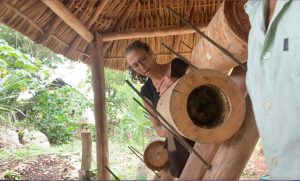How Maya stingless beekeeping can help us become better stewards of culture, the environment.
Research asks the question: How can we incorporate ancestral Indigenous ways of knowing and being to protect our environment and, ultimately, our species?
AUTHOR
Andrea Juarez, School of Architecture, Planning and Landscape

Veronica Briseño Castrejon cleans a jobon stingless bee beehive as part of her research in the Yucatan Peninsula.Courtesy Veronica Briseño Castrejon
For a School of Architecture, Planning and Landscape PhD candidate the vital contribution of Maya stingless beekeeping to the design of ecological cities, food sovereignty, and sociocultural well-being in the Yucatan Peninsula is a powerful example.
How this traditional practice can inform these dynamics is at the heart of Veronica Briseño Castrejón’s research — “Unveiling Maya Stingless Beekeeping in the Yucatan Peninsula of Mexico” — in the southeast of Mexico.
An ancestral practice, Maya stingless beekeeping integrates ecological and cultural ways of knowing that are linked intrinsically with Maya dwellings, traditional crops, and native species in the tropical forests of the Yucatan Peninsula.
“Pollinators like the Maya stingless bees are not only important for our food crops and to sustain the way we live, but also because they are part of the ways of being and knowing of the Maya, a culture that has a lot to share, including its wise knowledge and its relationship with nature and with life,” says Briseño.
According to Briseño, this practice represents a vital and interdependent balance of cultural norms and local biodiversity that has defined the management of the Maya territories in a sustainable manner for thousands of years.
As part of the study, Briseño also examines the power relations that, from the Maya perspective, undermine traditional stingless beekeeping practices and knowledge, such as current industrial projects that negatively impact the ecosystem, and traditional Maya dwellings and crops.
Urbanization and Maya stingless bees
International mega projects, industrial agrobusiness, solar panel and wind farms, mega pork farms, and deforestation for touristic and residential developments across the Yucatan peninsula profoundly impact and change the traditional dynamics in Maya communities, says Briseño.
These stressors dramatically impact pollinators such as bees, insects, birds, and bats, who affect 75 per cent of the world’s crop production and almost 90 per cent of the leading food crops worldwide. Currently, more than 40 per cent of wild pollinator species are at risk of extinction.
For this reason, Briseño studies the ancient design of Maya beekeeping and dwellings and compares them to the Maya biocultural landscapes and experiences of today, showcasing how Maya beekeeping has been impacted, what lessons can be brought back from the ancestral past, and how this learning can help preserve Maya stingless beekeeping.
Furthermore, native stingless bees, and Indigenous Maya traditional stingless beekeepers and peasants, are key to sustaining tropical forest, the last lungs of the world, …….
To read the complete article go to;
We are here to share current happenings in the bee industry. Bee Culture gathers and shares articles published by outside sources. For more information about this specific article, please visit the original publish source: How Maya stingless beekeeping can help us become better stewards of culture, the environment | News | University of Calgary (ucalgary.ca)






